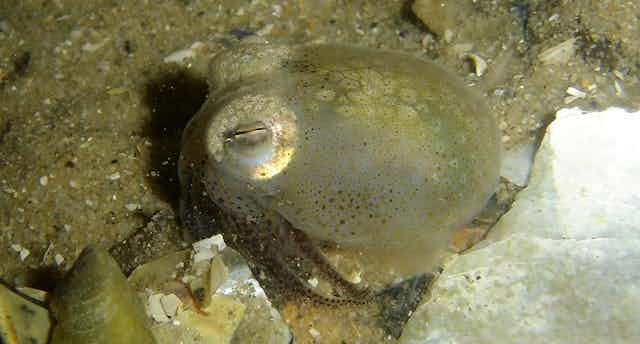In romantic circles, reproduction is viewed as a harmonious venture between the sexes. After all, if you aim to produce the best offspring possible, wouldn’t it also be best to cooperate with your partner?
In recent decades, however, evolutionary biologists have revealed this harmonious ideal could not be further from the truth. And, contrary to what you may think, males don’t always have the upper hand when it comes to sexual conflict.
In a paper published in Biology Letters last week, my colleagues and I showed female southern bottletail squid dictate which lucky male’s sperm they use to fertilise their eggs - and which unlucky sperm they eat instead.
Can’t we all just get along?
What is now clear is that fierce battles between the sexes are being fought almost everywhere you look in sexually-reproducing species.

The reasons underlying this “sexual conflict” are due to the different ways in which males and females maximise their reproductive success.
For males, reproduction is typically only limited by the number of mates he can find. Sperm is cheap to produce and they are plentiful, so males are expected to try to mate with as many females as possible.
For females, it’s more a case of quality rather than quantity. Compared to sperm, eggs are much more expensive to produce and there are fewer of them available to be fertilised so females are expected to maximise their reproductive success by mating with high quality suitors.
These differences in ideal mating strategies and reproductive costs are the key to sexual conflict.
With a mismatch as to what is an “optimal reproductive effort”, both males and females attempt to pay the lowest price for reproduction, while still getting the biggest “bang for their buck”.

Several studies have shown how such sexual conflict has resulted in some quite bizarre, and at times brutal, reproductive strategies.
Seed beetles, for example, have evolved almost barbaric looking penises, aimed specifically at damaging the internal reproductive tract of the female. Some male flies have even evolved ejaculates that not only stimulate the female to lay eggs, but also decrease her life span.
In such instances, males have evolved reproductive strategies aimed specifically at harming the female. By making the act of copulation even more costly for females, males lessen the likelihood of her mating again, thereby increasing his own chances of fertilising her eggs.
But are the scales of sexual conflict always tipped so heavily in the male’s favour?
Ejaculate on the menu
In the southern bottletail squid (Sepiadarium austrinum) females appear to engage in some reproductive manipulation of their own.
During copulation, males pass numerous sperm packages (spermatophores) to the female. These evert to form small, balloon-like structures (spermatangia) that glue to the membrane around her mouth on an area known as the buccal cavity. Here, they are stored until she is ready to fertilise her eggs.
Importantly, the male’s sperm do not enter the reproductive tract, instead remaining housed inside their balloon-like casings. Although these spermatangia do offer some protection, the external nature of the buccal cavity means females are only able to store them for about three weeks before they, and the numerous sperm within, are lost.
When she is ready to produce a clutch, she extracts an egg from her body with her arms, passes it across the stored sperm bulbs, and then places it on seaweed or in crevices on the sea floor.
But recently it has been found these females will also eat the male’s spermatangia after copulation. Furthermore, she uses the nutrients from this behaviour for both tissue growth and the development of her unfertilised eggs. You can see this behaviour in the video below.
As sperm storage is only short-term, if females do not lay eggs soon after mating, males could completely miss out on fertilising her eggs, and instead act as a contributor for the next male that comes along.
But are males entirely at the mercy of the females’ culinary whims?
Not all squid are equal
It appears that this exposure to ejaculate consumption has driven males to develop some counter-strategies of their own.
When assessing a female as a potential partner, males show a clear preference for larger females, often refusing to mate with sexually mature females that are too small. When we examined this closer, we actually found smaller females are the ones that will eat the most of the male’s ejaculate.

So males appear to be using female size as a way to minimise their exposure to ejaculate consumption.
By looking closely at this inconspicuous squid, we have uncovered a range of questions about cephalopod reproductive strategies.
Do females view males as a possible food source? Are they even assessing the quality of their mate, saving the sperm of the best males for egg fertilisation whilst eating the rest? Is it possible that males have even evolved manipulative strategies of their own to ensure their sperm is used in offspring production?
Regardless of what is around the corner, this research highlights how the evolutionary implications of a single adaptation can dramatically affect the life history of a species.
Such studies not only give us insight into the mysterious world of cephalopods, but also provide an understanding as to how the costs of reproduction have worked to shape the evolution of all sexually-reproducing species.

